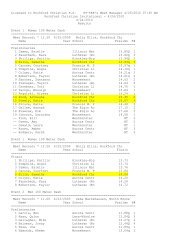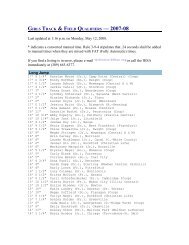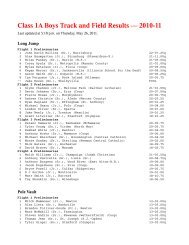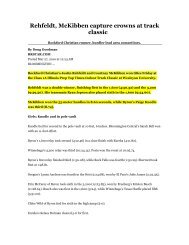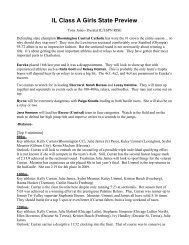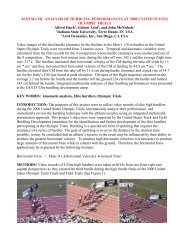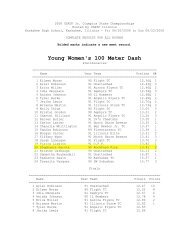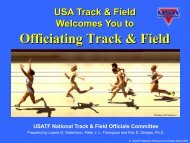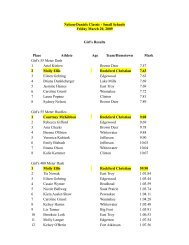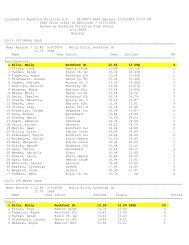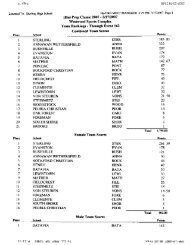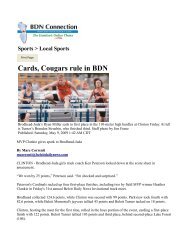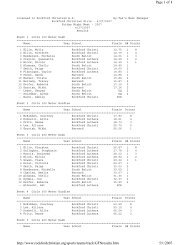The most effective technical training for the 110 metres hurdles
The most effective technical training for the 110 metres hurdles
The most effective technical training for the 110 metres hurdles
Create successful ePaper yourself
Turn your PDF publications into a flip-book with our unique Google optimized e-Paper software.
<strong>The</strong> <strong>most</strong> <strong>effective</strong> <strong>technical</strong> <strong>training</strong><br />
<strong>for</strong> <strong>the</strong> <strong>110</strong> <strong>metres</strong> <strong>hurdles</strong><br />
by Janusz Iskra<br />
H^fr] © by IAAF<br />
10:3:51-55,1995<br />
d (l Starting from <strong>the</strong> premise that success<br />
in Coaching <strong>the</strong> <strong>110</strong> <strong>metres</strong> <strong>hurdles</strong> depends<br />
first ofall on <strong>the</strong> athlete's possession of<strong>the</strong><br />
requisite physical and motor characteristics,<br />
<strong>the</strong> author describes how experience and <strong>the</strong><br />
adherence to basic sports principles can<br />
make it possible to construct a successful<br />
<strong>training</strong> plan <strong>for</strong> <strong>the</strong> individual athlete. He<br />
shows how an analysis of <strong>the</strong> experiences<br />
and methods of successful coaches can be<br />
used to seleet those <strong>training</strong> exercises which<br />
are of universal benefit and how <strong>the</strong>y can<br />
best be fitted into <strong>the</strong> <strong>training</strong> plan. Ten<br />
basic elements of technique <strong>training</strong> are discussed<br />
and copious examples given of exercises<br />
and <strong>training</strong> units by means of which<br />
<strong>the</strong>y can he developed. ^ ^<br />
Dr Janusz Iskra is a Polish National Coach<br />
<strong>for</strong> <strong>the</strong> 100 and 400 <strong>metres</strong> <strong>hurdles</strong>. He also<br />
teaches Physical Education at <strong>the</strong> Academy<br />
of Physical Education in Katowice, Poland.<br />
1 Introduction<br />
<strong>The</strong> <strong>110</strong> <strong>metres</strong> hurdle race belongs to <strong>the</strong><br />
group of athletic events in which a high<br />
motor potential is as important as <strong>the</strong> level<br />
of <strong>technical</strong> preparation. When skill preparation<br />
is based on <strong>the</strong> general rules of <strong>training</strong><br />
and experiences ga<strong>the</strong>red from o<strong>the</strong>r athletic<br />
events, especially from <strong>the</strong> sprints and<br />
jumps, <strong>the</strong> development of <strong>the</strong> technique of<br />
<strong>the</strong> <strong>110</strong> <strong>metres</strong> hurdle race eonstitutes a very<br />
specific part of <strong>the</strong> whole <strong>training</strong> process,<br />
Success in Coaching <strong>the</strong> <strong>110</strong> <strong>metres</strong> hurdle<br />
race depends first of all on <strong>the</strong> athlete possessing<br />
<strong>the</strong> appropriate somatic characteristics<br />
(especially length of leg) and <strong>the</strong> requisite<br />
motor abilities (speed and co-ordination),<br />
Upon this base it is possible to work out<br />
an optimal technique <strong>for</strong> every individual, If<br />
one considers <strong>the</strong> techniques and method of<br />
hurdle dearance worked out by <strong>the</strong> best<br />
Polish and <strong>for</strong>eign coaches. one may conciude<br />
that <strong>the</strong>re are as many ways of achieving success<br />
as <strong>the</strong>re are athletes. However it seems<br />
that <strong>the</strong> ancient saying "All roads lead to<br />
Rome' is only partially applicable to athletics<br />
<strong>training</strong>. <strong>The</strong> constant seareh <strong>for</strong> a new variety<br />
of <strong>technical</strong> <strong>training</strong> seems to be a very<br />
positive phenomenon, <strong>for</strong> it is responsible<br />
<strong>for</strong> <strong>the</strong> elimination of faults in technique and<br />
it motivates <strong>the</strong> hurdler to greater ef<strong>for</strong>ts.<br />
However, experiments of this type should<br />
also foilow ano<strong>the</strong>r ancient aphorism 'above<br />
all - do not härm <strong>the</strong> athlete'. In spite of perfectly<br />
selected exercises and proper Organisation,<br />
many new ideas may not only fall to<br />
produce <strong>the</strong> desired results but may also<br />
härm <strong>the</strong> athletes. In such cases, one should<br />
foilow <strong>the</strong> principle of <strong>the</strong> individualization<br />
of <strong>technical</strong> <strong>training</strong>.<br />
Aecording to this, <strong>the</strong> following factors<br />
should be taken into aecount:<br />
• <strong>the</strong> somatic constitution of <strong>the</strong> hurdler<br />
(height and body proportions),<br />
• <strong>the</strong> level of motor preparation (mainly<br />
speed, power and co-ordination). 51
52<br />
• <strong>the</strong> actual level of <strong>the</strong> <strong>technical</strong> preparation,<br />
which substitutes positive, correct<br />
<strong>for</strong>ms of movement <strong>for</strong> negative faults,<br />
• <strong>the</strong> psychological make-up,<br />
• <strong>the</strong> actual conditions (problems, injuries,<br />
illnesses).<br />
Taking <strong>the</strong>se factors into consideration. it<br />
is possible to choose a model of <strong>technical</strong><br />
preparation which would be optimal <strong>for</strong> <strong>the</strong><br />
given athlete, However in order to be equal<br />
to this task, one should have a wide ränge of<br />
exercises at one's command, from which one<br />
can seleet those exercises <strong>most</strong> specifically<br />
suitable to bring about <strong>the</strong> desired results,<br />
Obviously, in spite of a thorough evaluation<br />
of <strong>the</strong> athlete. <strong>the</strong>re are some o<strong>the</strong>r factors<br />
that influence <strong>the</strong> Organisation of <strong>the</strong> <strong>training</strong>;<br />
• <strong>the</strong> <strong>training</strong> period (phase)<br />
• <strong>the</strong> <strong>training</strong> objeetives<br />
• <strong>the</strong> <strong>training</strong> conditions (indoor or outdoor)<br />
• <strong>the</strong> wea<strong>the</strong>r conditions (wind, rain, air<br />
moisture),<br />
<strong>The</strong> ränge of <strong>technical</strong> <strong>training</strong> exercises is<br />
very wide. A great many specialists in <strong>the</strong> HO<br />
<strong>metres</strong> <strong>hurdles</strong> present ideas of perfeeting<br />
technique which are based on different<br />
grounds, Many of <strong>the</strong> same exercises are<br />
included but <strong>the</strong>y have different aims and<br />
order, On <strong>the</strong> o<strong>the</strong>r hand, all coaches have<br />
<strong>the</strong>ir own 'methods' which <strong>the</strong>y have found<br />
to be successful, It seems that, in spite of <strong>the</strong><br />
greal variety of <strong>technical</strong> exercises. it is possible<br />
to distinguish those particular elements<br />
which have <strong>the</strong> <strong>most</strong> beneficial influence on<br />
technique <strong>training</strong>. An analysis of <strong>the</strong> publications<br />
and experiences of many coaches<br />
makes it possible to distinguish 10 elements<br />
which eonstitute <strong>the</strong> structure of <strong>the</strong> <strong>110</strong><br />
<strong>metres</strong> <strong>hurdles</strong> <strong>technical</strong> <strong>training</strong>. Being<br />
familiär with <strong>the</strong>m and employing <strong>the</strong>ir various<br />
possibilities may help <strong>the</strong> coach to perfect<br />
<strong>the</strong> hurdler's technique and should consequently<br />
produce beiter resnits:<br />
<strong>The</strong> schematic presentation of <strong>the</strong> particular<br />
elements of <strong>110</strong> <strong>metres</strong> <strong>hurdles</strong> <strong>technical</strong><br />
<strong>training</strong> is presented in Table 1.<br />
2 Length of <strong>the</strong> race<br />
<strong>The</strong> velocity curve of <strong>the</strong> <strong>110</strong> <strong>metres</strong> <strong>hurdles</strong><br />
builds up from <strong>the</strong> start to <strong>the</strong> 2nd and<br />
3rd hurdle and from <strong>the</strong> 3rd to <strong>the</strong> 6th hurdle.<br />
after which velocity is maintained <strong>for</strong> a while<br />
and laier decreases. Accordingly, <strong>the</strong> <strong>110</strong><br />
<strong>metres</strong> hurdle race can be divided into 3<br />
phases:<br />
• start and hurdle acceleration<br />
• hurdle speed<br />
• hurdle endurance.<br />
Starting acceleration is derived from power<br />
and technique, hurdle speed depends on <strong>the</strong><br />
level of speed and technique. while <strong>the</strong> final<br />
part of <strong>the</strong> race depends on <strong>the</strong> maintenance<br />
of <strong>technical</strong> proficiency in <strong>the</strong> faee of growing<br />
muscular fatigue. <strong>The</strong>re is a significant difference<br />
in <strong>the</strong> <strong>technical</strong> <strong>training</strong> in each of <strong>the</strong>se<br />
phases.<br />
Example sessions:<br />
(h = hurdle, 107cm = height of hurdle,<br />
9,14m = inter hurdle space)<br />
A Hurdle acceleration:<br />
• 2xlh + 2x2h + 2x3h (107cm, 9,14m, crouch<br />
start),<br />
• 2x3h (100cm, 9,14m, crouch start) + 2x3h<br />
(107 cm. 9.14m crouch start),<br />
• 1-2-3-4-3-2-lh (107cm, 9,14m, crouch start),<br />
B Hurdle speed<br />
• 3-4-5-6-3h (100cm, 9.00m. standing start).<br />
• 2x5h (107cm. 9,14m. standing start) + 2x5h<br />
(107cm, 9,14m, crouch start) + 2x5h<br />
(100cm, 9.14m, crouch start) - 2x4h + 2x5h<br />
+ 2x6h (107cm, 9.14m, crouch start).<br />
Table 1:<br />
Model of <strong>technical</strong> <strong>training</strong> <strong>for</strong> <strong>the</strong><br />
<strong>110</strong>m <strong>hurdles</strong><br />
Element of rhythm <strong>training</strong><br />
1, Length of <strong>the</strong> race<br />
2. Rhythm<br />
3. Inter-hurdle spaces<br />
4. Height of <strong>the</strong> <strong>hurdles</strong><br />
5. Rest intervals<br />
6. Training intensity<br />
7. Length of <strong>the</strong> approach<br />
8. Length of <strong>the</strong> finish<br />
9. Type of start<br />
10. Technical exercises<br />
Characteristics<br />
• hurdle acceleration<br />
• hurdle speed<br />
• hurdle endurance<br />
• <strong>technical</strong> rhythm (1-2 strides)<br />
• classical rhythm (3 strides)<br />
• leng<strong>the</strong>ned rhythm (5.7 strides)<br />
• varied rhythmJ4,6 strides)<br />
• 3 stride rhythm - 8,5-9,14m<br />
• 5 stride rhythm - 12,8-13.40m<br />
• 7 slride rhythm - 17.3-18.20m<br />
• low <strong>hurdles</strong> - 76-84cm<br />
• medium <strong>hurdles</strong> - 91 cm<br />
• one metre <strong>hurdles</strong> - 100cm<br />
• high <strong>hurdles</strong> - 106,7cm<br />
• maximal - 5-90min<br />
• optimal-3-15min<br />
• shortened - 15sec-3min<br />
• maximal & sub-maximal/90-100%<br />
• high/80-90%<br />
• medium & low/80% and less<br />
• shortened approach/5-6 strides<br />
• Standard approach/7-8 strides<br />
• leng<strong>the</strong>ned approach/8-12 strides<br />
• shortened finish/2-3 strides<br />
• Standard finish/14.02m<br />
• leng<strong>the</strong>ned finistVl 4.02m and more<br />
• crouch start<br />
• standing start<br />
• trail leg<br />
• lead leg
C Hurdle endurance<br />
• 2x12h (84cm. 8.80m) + 2xl2H (91cm, 9m) +<br />
2x12h (100cm, 9.14m),<br />
• 4xllh (103cm, 9,05m, standing start),<br />
• 2x6h (100cm, 13,10m, 5 stride rhythm) +<br />
2x12h (100cm, 9.14m. 3 stride rhythm) +<br />
2x10h (107cm, 9m, 3 stride rhythm).<br />
3 Rhythm (<strong>the</strong> number of interhurdle<br />
strides)<br />
<strong>The</strong> 1-7-stride rhythms are used aecording<br />
to <strong>the</strong> requirements of <strong>the</strong> <strong>training</strong> period.<br />
<strong>the</strong> 3 stride (Standard) rhythm being <strong>the</strong> <strong>most</strong><br />
important. In <strong>the</strong> general preparation period<br />
hurdlers may take off from alternate legs (2,<br />
3 and 6 stride rhythm), in order to improve<br />
co-ordination in <strong>the</strong> preliminary <strong>technical</strong><br />
exercises. In <strong>the</strong> Special preparation period.<br />
when <strong>the</strong> hurdler is working on rhythm<br />
endurance. <strong>the</strong> 5 and 7 stride rhythms are<br />
used. <strong>The</strong> leng<strong>the</strong>ning of <strong>the</strong> inter-hurdle<br />
intervals facilitates <strong>the</strong> development of speed,<br />
which will later be transferred to <strong>the</strong> 3 stride<br />
rhythm technique. Various types of runs may<br />
be construeted by combining 3, 5 and 7 stride<br />
rhythms.<br />
Example sessions:<br />
A Technical rhythms:<br />
• 8x10h (84cm, 4,50m, 1 stride rhythm with<br />
trail leg),<br />
• 5x10h (84cm, 4m, 1 stride rhythm with trail<br />
leg) + 5x10h (84cm, 4,20m, 1 stride rhythm<br />
with lead leg).<br />
B Classical rhythms:<br />
• 6-8-10-12-6h (107cm, 9m, standing start).<br />
• 2x5h (107cm. 9.14m. crouch start) + 2x5h<br />
(107cm, 9.14m, standing start).<br />
C Leng<strong>the</strong>ned rhythms:<br />
• 4x10h (3-3-5-5-5-5-5-3-3-stride rhythm,<br />
100cm, 8.90/13m),<br />
• 3x8h (3-3-3-5-5-7-7-stride rhythm, 91cm,<br />
9m/13.10/17.50m).<br />
• 4x8h (3-5-3-5-3-5-3-stride rhvthm. 100cm,<br />
9.14/13,20m).<br />
• 5x8h (3-3-5-7-5-3-3-stride rhythm, 91cm,<br />
8,90/13.00/17.80m),<br />
D Alternating rhythms (both legs):<br />
• 6x6h (84cm, 10,50m, 4 stride rhythm with<br />
right and left leg).<br />
4 Inter-hurdle spaces<br />
This is one of <strong>the</strong> crucial elements in <strong>the</strong><br />
Organisation of rhythm <strong>training</strong>, Usually <strong>the</strong><br />
inter-hurdle Spaces expand in line with <strong>the</strong><br />
competition period. <strong>The</strong> following spaces are<br />
used aecording to <strong>the</strong> level of preparation,<br />
<strong>the</strong> <strong>training</strong> period. <strong>the</strong> height of <strong>the</strong> <strong>hurdles</strong><br />
and <strong>the</strong> wea<strong>the</strong>r conditions:<br />
• 3 stride rhythm: 8.50m. 8,70m, 8,90m. 9m,<br />
9,14m,<br />
• 5 stride rhythm: 12.90m, 13m, 13,10m,<br />
13.20m, 13,30m,<br />
• 7 stride rhythm: 17.30m. 17.80ra, 18m,<br />
18.20m, 18.40m.<br />
Examples of sessions:<br />
A Shortened spaces:<br />
• 3x10h (100cm, 8.80m) + 2x10h (107cm,<br />
8.90m),<br />
• 4xllh (100cm, 9m, l-4h + 8.90m, 4-9h +<br />
8.80m. 9-1 lh),<br />
(l-4h = from Ist to 4th hurdle),<br />
• 5x10h (100cm. inter-hurdle spaces are<br />
leng<strong>the</strong>ned in each run - 8.70m / 8.80m /<br />
8.90m/9m/9.14m),<br />
• 2x8h (91cm, 8.70m) + 2x8h (100cm, 8.90m)<br />
+ 2x8h (107cm, 9.14m).<br />
B Standard spaces (9.14m).<br />
5 Height of <strong>the</strong> <strong>hurdles</strong><br />
This, toge<strong>the</strong>r with <strong>the</strong> inter-hurdle spaces,<br />
provides a basic modification of <strong>the</strong> <strong>technical</strong><br />
<strong>training</strong>. Heights of 91, 100 and 106.70cm are<br />
used <strong>most</strong> often. Sometimes lower <strong>hurdles</strong><br />
are used (76-84cm) or artificially heightened<br />
(<strong>110</strong>-112cm). In some cases intermediate (eg.<br />
103cm) heights are used. which. aecording to<br />
many coaches does not cause any changes of<br />
speed or technique. Low <strong>hurdles</strong> (76-84cm)<br />
are used in <strong>the</strong> general preparation period. in<br />
order to perfect <strong>technical</strong> elements. Medium<br />
<strong>hurdles</strong> (91. 100cm) <strong>for</strong>m <strong>the</strong> basis of rhythm<br />
endurance <strong>training</strong> in <strong>the</strong> Special preparation<br />
period. High <strong>hurdles</strong> are used <strong>for</strong> <strong>the</strong> development<br />
of starting ability and as <strong>the</strong> basic<br />
hurdle height during <strong>the</strong> competition period,<br />
<strong>The</strong> height of <strong>the</strong> <strong>hurdles</strong> can remain unchanged<br />
throughout <strong>the</strong> <strong>training</strong> or can be<br />
changed in <strong>the</strong> case of certain <strong>training</strong> runs or<br />
even in in <strong>the</strong> course of one run.<br />
Examples of <strong>the</strong> hurdle height stipulations:<br />
A Low <strong>hurdles</strong> (76-84cm)<br />
• 6x5h (84cm, 6m. with trail and lead leg)<br />
• 5xl0H (84cm. 10m, 4 stride rhythm).<br />
B Medium <strong>hurdles</strong> and 1 metre <strong>hurdles</strong><br />
(91-100cm) 53
54<br />
• 6x8h (91cm. 13m, 5 stride rhythm)<br />
• 5x1 Oh (100cm, 8.80m, standing start)<br />
• 3x10h (91cm, 8.80m) + 2x10h (100cm, 9m).<br />
C High <strong>hurdles</strong> (107cm)<br />
• 3x2h + 3x4h (107cm, 9.14m. crouch start)<br />
• 3x10h (107cm l-5h + lOOem 6-10h. 9m.<br />
standing start).<br />
6 Rest intervals<br />
Modelling of <strong>the</strong> <strong>technical</strong> <strong>training</strong> by<br />
means of <strong>the</strong> durations of rest intervals refers<br />
to both repetitions and <strong>the</strong> series of exercises.<br />
<strong>The</strong> length and <strong>the</strong> character of <strong>the</strong>se intervals<br />
depend on <strong>the</strong> <strong>training</strong> method and <strong>the</strong><br />
intensity of ef<strong>for</strong>t. If <strong>the</strong> duration of <strong>the</strong> intervals<br />
is insufficient, we may use so called "hurdler's<br />
intervals'. <strong>The</strong> rest intervals may be:<br />
A Maximum — 5min-1.5 hours - used<br />
<strong>for</strong> races of maximum intensity:<br />
• 2x<strong>110</strong>m <strong>hurdles</strong>, i = 60min<br />
(i = time of interval),<br />
• <strong>110</strong>m <strong>hurdles</strong> (100cm, 9.14m, crouch start)<br />
+ 60m <strong>hurdles</strong> (107cm, 9.14m. crouch start).<br />
i = 20min,<br />
• 4x2h (107cm, 9.14m. group Starts), i = 6min.<br />
B Optimal - 3-15min - used <strong>for</strong> <strong>most</strong><br />
of<strong>the</strong> <strong>technical</strong> <strong>training</strong>:<br />
• 5x1 lh (103cm. 9m, standing start), i = 8min,<br />
• 2x8h + 2x6h + 2x4h (100cm, 8.9ra, standing<br />
start), i = 6, 5, 4min (repetitions) / 10min,<br />
(sets),<br />
C Shortened 15sec-3min<br />
This eonstitutes <strong>the</strong> basis <strong>for</strong> interval <strong>training</strong>,<br />
<strong>The</strong> intervals are designed to intensify<br />
work on <strong>the</strong> hurdler's endurance and <strong>the</strong>y<br />
may take various <strong>for</strong>ms:<br />
• 3x2x5h (91cm, 8,80m), i=l/6min (intervals<br />
passive, shortened),<br />
• 4x2x8h (100cm, 8.90m), i = walk/6min<br />
(walk back intervals),<br />
• 3x3x3h (107cm, 9m), i = jog/6min (jog back<br />
intervals),<br />
• 4x4x5h (100cm, 8,80m), back to back with a<br />
pause <strong>for</strong> <strong>the</strong> change of direction).<br />
7 Training intensity<br />
This depends mainly on <strong>the</strong> <strong>training</strong> period,<br />
<strong>the</strong> <strong>training</strong> objeetive, <strong>the</strong> State of <strong>the</strong> athlete<br />
and <strong>the</strong> <strong>training</strong> conditions (temperature,<br />
wind. rain). Usually, <strong>the</strong> following rule is observed:<br />
<strong>the</strong> higher <strong>the</strong> intensity, <strong>the</strong> smaller<br />
<strong>the</strong> number of units covered. <strong>The</strong> same rule<br />
applies to <strong>the</strong> rest intervals: <strong>the</strong> higher <strong>the</strong> intensity<br />
- <strong>the</strong> longer <strong>the</strong> rest intervals. Sometimes,<br />
in a single <strong>training</strong> session, <strong>the</strong> same<br />
hurdle runs may used but at different intensities,<br />
As <strong>the</strong> competition period approaches<br />
<strong>the</strong> intensity of <strong>the</strong> runs increases.<br />
Examples of <strong>the</strong> <strong>technical</strong> <strong>training</strong>:<br />
A Maximal and sub-maximal intensity<br />
• Competitions or tests.<br />
B High intensity - hurdle accelerations,<br />
variations of hurdle speed and hurdle<br />
endurance:<br />
• 3x14h (100cm, 9,14m, standing start), i =<br />
12min, I (intensity) = 90%,<br />
• 1-2-3-2-lh (107cm, 9,14m, crouch start,<br />
group races), i = 5-10min, I = 90%,<br />
• 1x10h (1=90%) + 1x10h (1=80%) + IxlOh<br />
(1=95%).<br />
C Medium and low intensity — <strong>technical</strong><br />
exercises, walking and jogging:<br />
• 5x8h (100cm, 7m, with trail and lead leg).<br />
8 Length of approach<br />
This may be Standard (13,72m), shortened<br />
(5-6 strides) or leng<strong>the</strong>ned (9-12 strides).<br />
Examples:<br />
A Shortened approach:<br />
• 3x2h (107cm, 9,14m, crouch start, approach<br />
with 5 strides = approx, 10m),<br />
B Leng<strong>the</strong>ned approach:<br />
• 4x4h (100cm, 9m, crouch start, approach<br />
with 9 strides = approx. 18m),<br />
C Standard approach:<br />
• 2x2h + 2x4h (107cm, 9.14m, approach Standard<br />
minus 50cm).<br />
9 Length of <strong>the</strong> finish<br />
This element of rhythm <strong>training</strong>, designed<br />
to perfect firiisliiny auiliiy, ib often neglected.<br />
Most often no attention is paid to continuing<br />
to run on after crossing <strong>the</strong> last hurdle, which<br />
encourages a faulty sequence of movement.<br />
Generally it is sufficient to take 2 or 3 quick<br />
strides after crossing <strong>the</strong> last hurdle but it is<br />
sometimes useful to leng<strong>the</strong>n <strong>the</strong> finish to<br />
14.02m or even beyond (approx. 20m) <strong>the</strong><br />
normal distance.<br />
Examples:<br />
A Shortened finish:<br />
• 6x6h (100cm, 9,14m. crouch start).<br />
• fast 2-3 strides after last hurdle dearance.
B Standard finish (14.02m)<br />
C Leng<strong>the</strong>ned finish<br />
• 5x4h (107cm, 9,14m, crouch start),<br />
• fast finish to 60 <strong>metres</strong>,<br />
10 Type of start<br />
<strong>The</strong> use of <strong>the</strong> crouch or standing start<br />
depends on <strong>the</strong> period of preparation and <strong>the</strong><br />
type of <strong>the</strong> rhythm <strong>training</strong>. In <strong>the</strong> case of<br />
rhythm endurance <strong>training</strong> (more than 7 <strong>hurdles</strong>)<br />
<strong>the</strong> crouch start is used very rarely. In<br />
<strong>the</strong> pre-competition period, on <strong>the</strong> o<strong>the</strong>r<br />
hand, in exercises dealing with <strong>the</strong> unit from<br />
<strong>the</strong> 3rd to 5th hurdle. <strong>the</strong> crouch start is necessary.<br />
In order to get <strong>the</strong> ut<strong>most</strong> benefit<br />
from <strong>technical</strong> <strong>training</strong>. il should be remembered<br />
that too many block Starts may be<br />
stressful and have a negative <strong>training</strong> effeet.<br />
Standing Starts are usually carried out without<br />
a signal, whereas crouch Starts require <strong>the</strong><br />
starting command.<br />
Example session:<br />
A Crouch start:<br />
• 2xlh + 2x2h + 2x3h (107cm, 9,14m, crouch<br />
start. group races),<br />
B Standing start:<br />
• 4x13h (100cm, 9m, high start, individual<br />
races).<br />
11 Use of <strong>the</strong> basic <strong>technical</strong> exercises<br />
This refers to <strong>the</strong> use of various hurdle<br />
exercises per<strong>for</strong>med by <strong>the</strong> trail leg and lead<br />
leg. <strong>The</strong>se exercises <strong>for</strong>m <strong>the</strong> basis <strong>for</strong> <strong>technical</strong><br />
<strong>training</strong> in <strong>the</strong> general preparation period<br />
and are used as <strong>the</strong> introduetory part of all<br />
rhythm <strong>training</strong> units. Technical <strong>training</strong><br />
exercises are useful at all levels of proficiency<br />
<strong>for</strong> <strong>the</strong> whole <strong>training</strong> period.<br />
Example sessions:<br />
A Trail leg:<br />
• 4x8h (100cm, 7.5m, 3 stride rhythm),<br />
• exercises <strong>for</strong> <strong>the</strong> trail leg at a jog.<br />
B Lead leg:<br />
• 5x8h (91cm, Im, 1 stride rhythm),<br />
• exercises <strong>for</strong> <strong>the</strong> lead leg at a walk.<br />
On reviewing some of <strong>the</strong> basic elements<br />
that influence <strong>the</strong> structure of <strong>technical</strong> <strong>training</strong><br />
<strong>for</strong> <strong>the</strong> <strong>110</strong>m <strong>hurdles</strong>, it can be seen that a<br />
great number of variations and combinations<br />
can be used. <strong>The</strong>ir value can be verified if<br />
<strong>the</strong>y are based on practice with an individual<br />
athlete. However it should also be remembered<br />
that success cannot serve as <strong>the</strong> decisive<br />
criterion <strong>for</strong> <strong>the</strong> use of any one group of<br />
exercises. Aecording to <strong>the</strong> classical principle<br />
of sport <strong>training</strong> <strong>the</strong>ory, every year 20% of<br />
<strong>the</strong> exercises should be changed. In order to<br />
do this, it is necessary to be well acquainted<br />
with <strong>the</strong> variety of exercises available and <strong>the</strong><br />
ways in which <strong>the</strong>y can be usefully adapted.<br />
[?S]<br />
55



